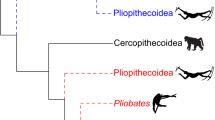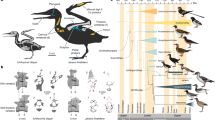Abstract
The anatomy of the posterior basicranium has been repeatedly invoked in systematic definitions of Primates. One widely cited definition1,2 of the order claims that ‘all undoubted primates’3 are distinguished from other mammals by two basicranial specializations: (1) absence of a major vascular foramen on the medial side of the auditory region, and (2) development of the auditory bulla from the petrosal bone. As we show here, specialization (1) does not apply to the paromomyid Ignacius, and is of uncertain incidence in other unquestioned members of suborder Plesiadapiformes (archaic primates from the early Cenozoic of Europe and North America). Specialization (2) cannot be demonstrated without ontogenetic evidence, and all relevant plesiadapiform fossils are adult. In fact, the only plesiadapiform with an arterial pattern remotely resembling that of early primates of modern aspect (or ‘euprimates’4) is the microsyopid Cynodontomys, but it is often regarded as non-primate because it lacks a petrosal bulla. Although plesiadapiforms resemble euprimates in traits of the cheek teeth and postcranium5–7, some other (presumably non-primate) groups possess these traits as well. Since the order Primates is not clearly definable by unique specializations, the best grounds for regarding plesiadapiforms as euprimate antecedents are stratigraphic and phenetic. This fact may be best expressed by systematic arrangements that emphasize adaptive grades rather than unsubstantiated clades.
This is a preview of subscription content, access via your institution
Access options
Subscribe to this journal
Receive 51 print issues and online access
$199.00 per year
only $3.90 per issue
Buy this article
- Purchase on Springer Link
- Instant access to full article PDF
Prices may be subject to local taxes which are calculated during checkout
Similar content being viewed by others
References
Szalay, F. S. in Phytogeny of the Primates, a Multidisciplinary Approach (eds Luckett, W. P. & Szalay, F. S.) 91–125 (Plenum, New York, 1975).
Szalay, F. S. & Delson, E. Evolutionary History of the Primates (Academic, New York, 1979).
Szalay, F. S. in The Functional and Evolutionary Biology of Primates (ed. Tuttle, R.) 3–35 (Aldine, Chicago, 1972).
Hoffstetter, R. Bull. Mém. Soc. Anthrop. Paris (sér. 13) 4, 327–347 (1977).
Simpson, G. G. Am. Mus. Novit. 816, 1–30 (1935).
Szalay, F. S. Evolution 22, 19–36 (1968).
Gingerich, P. D. Pap. Paleontol. Univ. Michigan Mus. Paleontol. 15, 1–140 (1976).
Archibald, J. D. J. hum. Evol. 6, 609–622 (1977).
McKenna, M. C. Folia primatol. 4, 1–25 (1966).
Szalay, F. S. Bull Am. Mus. nat. Hist. 140, 193–330 (1969).
Saban, R. Mém. Mus. natn Hist. nat., Paris (sér. A) 29, 1–278 (1963).
Russell, D. E. Mém. Mus. natn Hist. nat., Paris (sér. C) 13, 1–324 (1964).
Szalay, F. S. Am. J. phys. Anthrop. 36, 59–76 (1972).
MacPhee, R. D. E. Contr. Primatol. 18, 1–282 (1981).
Cartmill, M. in Phyhgeny of the Primates, a Multidisciplinary Approach (eds Luckett, W. P. & Szalay, F. S.) 313–354 (Plenum, New York, 1975).
Story, H. E. Fieldiana, Zool. 32, 477–557 (1951).
Guthrie, D. A. Bull. Mus. comp. Zool. 128, 455–481 (1963).
Bugge, J. Acta anat. (Suppl. 62) 87, 1–160 (1974).
Butler, H. Int. J. Primatol. 1, 333–343 (1980).
Presley, R. Acta anat. 103, 238–244 (1979).
Cartmill, M. & MacPhee, R. D. E. in Comparative Biology and Evolutionary Relationships of Tree Shrews (ed. Luckett, W. P.) 95–132 (Plenum, New York, 1980).
Van Valen, L. Evolution 19, 137–151 (1965).
Szalay, F. S. J. hum. Evol. 6, 3–18 (1977).
MacPhee, R. D. E. Folia primatol. 31, 23–47 (1979).
Klaauw, C. J. van der Bull. Am. Mus. nat. Hist. 62, 1–352 (1931).
Szalay, F. S. & Decker, R. L. in Primate Locomotion (ed. Jenkins, F. A.) 223–259 (Academic, New York, 1974).
Szalay, F. S., Tattersall, I. & Decker, R. L. Contr. Primatol. 5, 136–166 (1975).
Szalay, F. S. & Drawhorn, G. in Comparative Biology and Evolutionary Relationships of Tree Shrews (ed. Luckett, W. P.) 133–169 (Plenum, New York, 1980).
Lewis, O. J. J. Anat. 131, 275–298 (1980).
Novacek, M. J. in Comparative Biology and Evolutionary Relationships of Tree Shrews (ed. Luckett, W. P.) 35–93 (Plenum, New York, 1980).
Cartmill, M. in A History of American Physical Anthropology 1930–1980 (ed. Spencer, F.) 147–186 (Academic, New York, 1982).
Gingerich, P. D. J. hum. Evol. 10, 345–374 (1981).
Author information
Authors and Affiliations
Rights and permissions
About this article
Cite this article
MacPhee, R., Cartmill, M. & Gingerich, P. New Palaeogene primate basicrania and the definition of the order Primates. Nature 301, 509–511 (1983). https://doi.org/10.1038/301509a0
Received:
Accepted:
Issue Date:
DOI: https://doi.org/10.1038/301509a0
This article is cited by
-
The phylogenetic system of primates—character evolution in the light of a consolidated tree
Organisms Diversity & Evolution (2016)
Comments
By submitting a comment you agree to abide by our Terms and Community Guidelines. If you find something abusive or that does not comply with our terms or guidelines please flag it as inappropriate.



